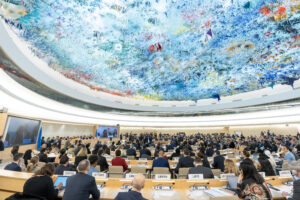III. OVERVIEW OF DISCUSSIONS
B. Manifestations and causes of gender-motivated killings of women: current trends and regional perspectives (session 1)
12. In this session, presenters discussed the prevalence, manifestations and causes of gender-motivated killings of women in different parts of the world, drawing upon specific national or regional trends, particularities and recent developments. This included information on the physical manifestations of killings, their legal, political, socioeconomic and cultural contexts and how killings are situated in the continuum of violence against women.
Presentations also examined legislative measures to prevent killings and good practices and challenges in preventing, investigating and prosecuting gender-motivated killings of women as well as strategies to encourage data collection and reporting. States’ compliance with their due diligence obligation and measures undertaken by States to combat impunity of perpetrators and ensuring accountability was given particular emphasis.
13. Dowry-related killings of women, suicides and self-immolation (South Asia), killings of women as a result of intimate partner violence (Europe), killings of women accused of sorcery and witchcraft (Africa and the Pacific), honour-related killings of women (Middle East and North Africa) and extreme forms of gender-motivated killings of women (femicides) in Latin America were among the different manifestations discussed in this session. Participants also examined gender-motivated killings of women on the basis of sexual orientation and identity and ethnic or racial origins and in the context of armed conflict, underscoring the emphasis of the mandate on the multiple forms and intersectionality of discrimination and violence.
2. Manifestations and causes of gender-motivated killings: specific contexts
20. The difficulty of gathering information on the prevalence and manifestations of gender-motivated killings of women was highlighted in the examination of gender- motivated killings on the basis of sexual orientation and gender identity. Reluctance to report such crimes due to stigma was particularly challenging. It was noted that this problem was compounded by the fact that many of such killings were concealed behind the shame that the perceived transgression of sexual identity was considered to bring about. While gender-motivated killings were a global phenomenon, the presentation underlined the importance of recognizing the different causes thereof, depending on the specific local, national or regional context. In that respect, in order for States to respond effectively, the importance of assessing prevailing stereotypes and addressing the social or cultural or economic factors and belief systems that underpinned such attitudes and values (including “honour”) was emphasized. The often aggravated nature of these killings, the prevalence of violence and killings of that group of women in the family sphere and the social intolerance and harassment that might lead to suicides among lesbian, transgender and bisexual women were highlighted. Good practices and studies of the Council of Europe and the Organization of American States were referred to.
IV. CONCLUSIONS
27. Participants of the expert group meeting identified a number of concerns, challenges and recommendations relating to gender-motivated killings of women and States’ responsibility to prevent, respond to and provide remedies for these human rights violations. These will be explored and developed in depth in the report of the Special Rapporteur to the Human Rights Council at its twentieth session (A/HRC/20/16).
28. The killing of women because they are women is a global phenomenon. In some parts of the world, gender-motivated killings of women are on the increase. They are often located at the end of a continuum of violence against women, set against general patterns of discrimination against women and tolerated impunity of perpetrators. While manifestations, prevalence and causes differ between regions in response to specific local contexts, many similarities exist.
Notably, the meeting accentuated the particular vulnerability of certain groups of women to gender-motivated killings due to the intersectionality between discrimination on the grounds of ethnicity, race, beliefs, sexual orientation, social status, migration or other status, on the one hand, and violence against women, on the other. The meeting confirmed that the violent nature of killings often included sexual violence.
Link to full text of the report:
http://www.ohchr.org/Documents/HRBodies/HRCouncil/RegularSession/Session20/A-HRC-20-16-Add4_en.pdf




